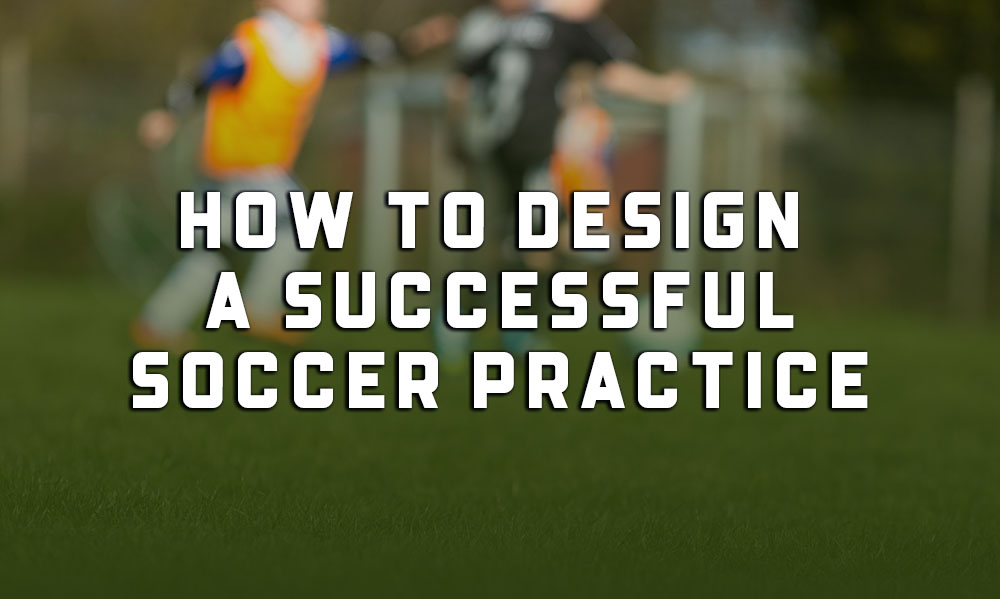Lesson 8: How To Design A Youth Soccer Practice

Ready to start designing your own youth soccer practices? Regardless of age, ability level, or topic, successful practices all have several things in common:
- They have a focused topic
- They progress from simple to complex
- They are dynamic (no laps, no lines, no lectures)
- They are fun
Finding Your Topic
While observing coaches work with their teams, you will often see novice coaches design a practice that address a wide range of topics in one practice. For example, a coach will watch their team play the weekend before and say after “we were poor at passing, dribbling, and shooting.” At their next practices they will have designed a practice with three activities: one for passing, one for dribbling, and one for shooting.
It may seem like a good use of time, but not focusing on a single topic for a practice makes it difficult to get information across to your players, doesn’t give them the repetition and opportunity to understand the topic, and will leave everyone frustrated as nothing will really be learned or understood.
Instead, decide on a topic and spend time developing it within that practice. Most clubs will have a curriculum they want their coaches to follow which outlines all the topics they want hit in a season at each age. If so, follow that regardless of what your team did well/poorly the weekend before. If not, try to put together a plan yourself of what you want to address throughout the season. You can find examples of topics to address through our soccer drills page (just sort by age).
Simple to Complex
Now that you have your topic, it’s time to develop and teach it to your players. The United States Soccer Federation (USSF) has advocated for a play-practice-play method, where every practice starts with a small-sided 2v2, 3v3, or 4v4 game at the start of practice (example). This helps the players get active quickly, get lots of touches on the ball, and starts the practice off with a fun vibe (because who doesn’t like to scrimmage?!).
From there, we want our activities to start with simple activities, which introduce the skill being taught, and then each subsequent activity adds a new element of the game. For example:
Activity 1 – Small-Sided Game
- This gets the players moving and into a “soccer mindset.” View our list of 120+ small sided soccer games here.
Activity 2 – Limited Pressure
- Introduce an activity which has limited or no pressure on the players with the ball (for example, a defender). It allows players to practice the skill without having a worry about an opponent tackling them. Gives an opportunity for the coach to fix problem with each players’ technique.
Activity 3 – Pressure and Direction
- Expand on your topic by now playing an activity which has a direction (usually going to different goals), and pressure on the ball (meaning, it has an opponent or a time limit).
Activity 4 – Game
- Now play a game with teams. No restrictions, two goals, and normal soccer rules. Simple to complex! After we’ve played a small-sided game at the start, we’ve allowed a phase of our practice to introduce the skill and let players practice it with minimal or no pressure, then we’ve added pressure and direction to make it more game realistic, then we’ve moved it fully into a game. You can add more activities than just the four examples shown, just make sure each one is a little more like an actual soccer game than the one before.
Keeping Practices Dynamic
This topic is further discussed here, and is very important in order to properly teach the many phases of the game while simultaneously keeping your players’ interest and motivation high. If you constantly have practices with long lines, then you will:
- Cause your players to get bored. Who wants to stand in line for a long time?
- Waste your practice time. One player is on task and working on a technique while everyone else is standing waiting
- Improperly prepare your players.
A full game never has only one player shooting on an empty net with no pressure. That’s why it’s important to get players under pressure and in game realistic moments each practice…it better prepares them for what they may experience in a game A good rule of thumb for each dynamic practice is: No Laps, No Lines, No Lectures.
Don’t send your kids running on laps, as it doesn’t get them fit and wastes your valuable practice time. Don’t use physical activity as a punishment.
Avoid lines and, if you can’t, keep them small and moving quickly.
Keep your coaching points succinct. Commercials on TV average 15 seconds these days. Why? Because that’s the average attention span for an adult. A child’s is even shorter, so make your point and get them playing again.
How to Keep Things Fun
Too many practices, from novice and experienced coaches alike, just don’t look fun. Players aren’t trying and there aren’t many smiles. So, what does a fun practice look like?
- The coach is kind and has a positive and welcoming attitude. Players enjoy playing for a coach who they believe genuinely cares about them.
- The practice is dynamic. It flows and there aren’t a lot of stoppages or time in line waiting.
- There are lots of touches on the ball. Players are engaged.
- The practice always has a scrimmage. Soccer is fun, it’s why the kids are there. Make sure to let them play without you coaching them each practice.
Soccer Drive has entire practice plans already created for each age level which follow all the methods described above here: Soccer Practice Sessions. However, designing your own helps inject your personality and creativity into the team. All practices are different, but following the guidelines listed above, no matter what activities you play, will help you developing your players and keeping them active.
